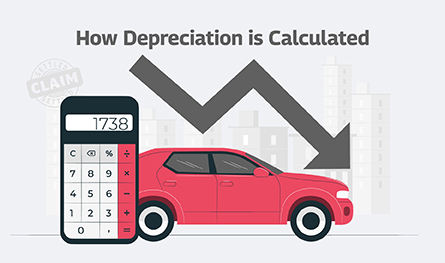What is the schedule of depreciation on different items?
.png)
The true purpose of having a comprehensive motor insurance policy is felt without a doubt when your vehicle suffers damages and you make a motor insurance claim. When the insurance company pays the cost of repairs which, otherwise, had been your headache, you feel a sense of calm and relief. But your calm and relief is short-lived when the repair costs are not paid in full. The insurance company makes some deductions in the total repair bills and then the claim is settled. Have you wondered why such deductions are made?
.png)
Deductions from your motor insurance claim are done, mainly, for two reasons. One is the portion of compulsory deductible which represents the mandatory amount of claim paid out of your pockets. The other is the depreciation on your vehicle’s parts which have been repaired. This rate of motor insurance depreciation chart is different for different parts of the vehicle. Do you know this schedule of depreciation? No? Let’s find out:
Schedule of depreciation on different parts of the vehicle.
| For the plastic and rubber parts of the vehicle | The rate of depreciation is 50% |
| For the fiber glass parts of the vehicle | The rate of depreciation is 30% |
| For other metallic parts of the vehicle | The rate of depreciation is 0% for the first 6 months. From the 7th month onwards, the rate of depreciation depends on the age of the car. It is 5% in the first year, 10% in the second year, 15% in the third year and so on |
| For any paint related job done as a part of repairs | The rate of depreciation is 50% |
So, when the claim is settled for repairs done to different parts, the liability of the insurance company is determined after deducting the relevant depreciation of each part.
Your vehicle as a whole is also subject to motor insurance depreciation chart. This depreciation is reflected in the decreasing Insured declared Value (IDV) of your vehicle. The IDV of your vehicle is your motor insurance policy’s Sum Insured. It is calculated by deducting depreciation from the listed Market price of your vehicle. The rate of depreciation increases every year as your vehicle ages and so, consequently, the IDV of your vehicle decreases. The rate of depreciation for computing your vehicle’s IDV is as follows:
| Age of the vehicle | Rate of depreciation |
| Less than 6 months | 5% |
| More than 6 months but less than 1 year | 15% |
| More than 1 year but less than 2 years | 20% |
| More than 2 years but less than 3 years | 30% |
| More than 3 years but less than 4 years | 40% |
| More than 4 years but less than 5 years | 50% |
The IDV of your vehicle becomes relevant in case your vehicle is damaged beyond repairs or in case it is stolen. If your vehicle is so badly damaged that the repair costs exceed 70% of the IDV, the insurance company declares the claim to be a Total Constructive Loss. In this case, the IDV less the wreck value (scrap value) would be paid. Similarly, when your vehicle is stolen, the insurance company pays your vehicle’s IDV and settles the claim.
So, whenever you make a claim in your motor insurance policy, remember the schedule of depreciation on different parts of your vehicle and also on the vehicle as a whole to understand the deductions made by the insurance company in settling your claim.
Choose wisely!
Schedule of Depreciation on Different Item
A depreciation schedule consists of what? All construction costs and assets, including prior renovations (whether carried out by you or a previous owner), as well as a more aggressive claim for low cost and low value assets, will be included in high quality investment property depreciation schedules.
The straight line method depreciates your business asset by the same amount each year for the duration of its useful life. The annual depreciation expense is calculated by dividing the depreciable value of each asset (cost minus salvage value, or the value at the end of the asset's useful life) by the asset's useful life.
Assets that don't diminish in value over time or that you aren't currently using to generate income cannot be depreciated. These consist of: Land. collectibles such as works of art, coins, or artifacts.
Depreciation determined using an asset's useful life as per Schedule II is specific to using the asset for a single shift. When an asset is utilized over the course of multiple shifts, the depreciation must be computed appropriately.

Author Bio
Paybima Team
Paybima is an Indian insurance aggregator on a mission to make insurance simple for people. Paybima is the Digital arm of the already established and trusted Mahindra Insurance Brokers Ltd., a reputed name in the insurance broking industry with 21 years of experience. Paybima promises you the easy-to-access online platform to buy insurance policies, and also extend their unrelented assistance with all your policy related queries and services.
Other Motor Insurance Products
Latest Post
.jpg)
Having a bike is not just about convenience, it’s a huge responsibility. Financial protection of your two-wheeler is important and the best way to ensure that is to have a bike insurance policy that will protect you in case of an accident, theft or a natural calamity. There are so many options when it comes to policies, making it difficult to know what’s best. This guide makes it easier to choose the best bike insurance policy that is suitable for you.


Non-linked, non-participating term plans are the ones that do not participate in the business and profit of the insurance company. These are fixed premium plans where the policyholder pays a fixed amount to ascertain a guaranteed sum as a return to be paid to the nominee in case of his/ her demise. Let’s learn more in this post.


Car depreciation implies the difference between the cost of a car at the time of buying the car and when you sell it. A car insurance claim amount is determined by the car depreciation rate. The car depreciation rate is the reduction in the value of your car over its lifespan caused by wear and tear.


Have you ever caught yourself lost in illusions about your daughter's future events, such as her university convocation and first day at work? Her university convocation. When she embarks upon her initial job after graduation will be the day.

.png)
Accidents can happen anywhere, anytime, by your own fault or another person. What’s important is to be prepared for such mishaps. This is where Own Damage Car Insurance comes in handy.




